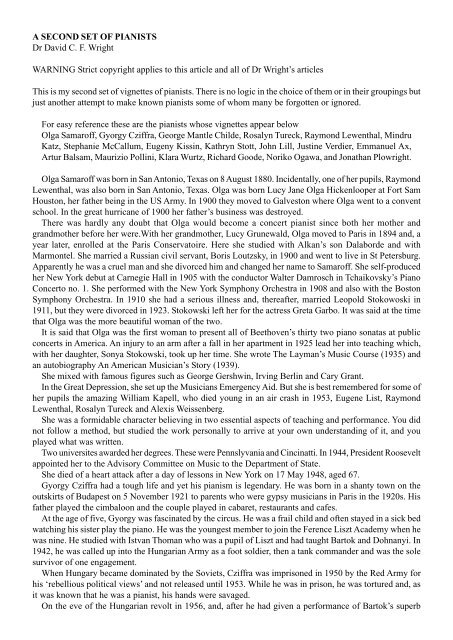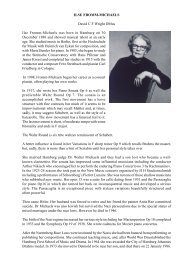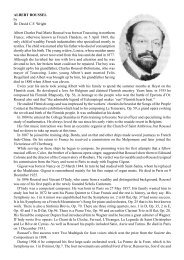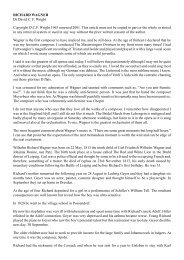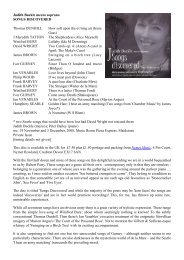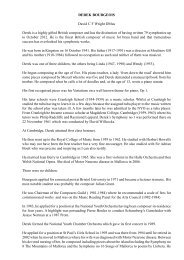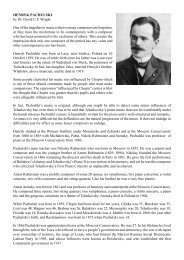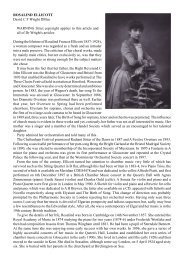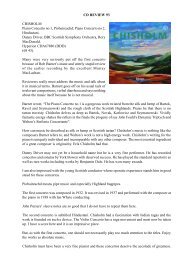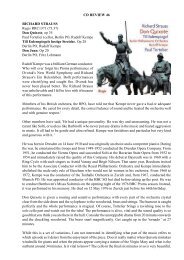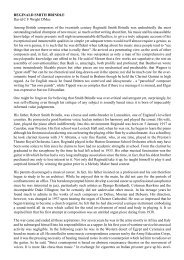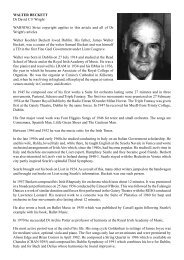A Second Set of Pianists - Dr David Wright
A Second Set of Pianists - Dr David Wright
A Second Set of Pianists - Dr David Wright
You also want an ePaper? Increase the reach of your titles
YUMPU automatically turns print PDFs into web optimized ePapers that Google loves.
A SECOND SET OF PIANISTS<strong>Dr</strong> <strong>David</strong> C. F. <strong>Wright</strong>WARNING Strict copyright applies to this article and all <strong>of</strong> <strong>Dr</strong> <strong>Wright</strong>’s articlesThis is my second set <strong>of</strong> vignettes <strong>of</strong> pianists. There is no logic in the choice <strong>of</strong> them or in their groupings butjust another attempt to make known pianists some <strong>of</strong> whom many be forgotten or ignored.For easy reference these are the pianists whose vignettes appear belowOlga Samar<strong>of</strong>f, Gyorgy Cziffra, George Mantle Childe, Rosalyn Tureck, Raymond Lewenthal, MindruKatz, Stephanie McCallum, Eugeny Kissin, Kathryn Stott, John Lill, Justine Verdier, Emmanuel Ax,Artur Balsam, Maurizio Pollini, Klara Wurtz, Richard Goode, Noriko Ogawa, and Jonathan Plowright.Olga Samar<strong>of</strong>f was born in San Antonio, Texas on 8 August 1880. Incidentally, one <strong>of</strong> her pupils, RaymondLewenthal, was also born in San Antonio, Texas. Olga was born Lucy Jane Olga Hickenlooper at Fort SamHouston, her father being in the US Army. In 1900 they moved to Galveston where Olga went to a conventschool. In the great hurricane <strong>of</strong> 1900 her father’s business was destroyed.There was hardly any doubt that Olga would become a concert pianist since both her mother andgrandmother before her were.With her grandmother, Lucy Grunewald, Olga moved to Paris in 1894 and, ayear later, enrolled at the Paris Conservatoire. Here she studied with Alkan’s son Dalaborde and withMarmontel. She married a Russian civil servant, Boris Loutzsky, in 1900 and went to live in St Petersburg.Apparently he was a cruel man and she divorced him and changed her name to Samar<strong>of</strong>f. She self-producedher New York debut at Carnegie Hall in 1905 with the conductor Walter Damrosch in Tchaikovsky’s PianoConcerto no. 1. She performed with the New York Symphony Orchestra in 1908 and also with the BostonSymphony Orchestra. In 1910 she had a serious illness and, thereafter, married Leopold Stokowoski in1911, but they were divorced in 1923. Stokowski left her for the actress Greta Garbo. It was said at the timethat Olga was the more beautiful woman <strong>of</strong> the two.It is said that Olga was the first woman to present all <strong>of</strong> Beethoven’s thirty two piano sonatas at publicconcerts in America. An injury to an arm after a fall in her apartment in 1925 lead her into teaching which,with her daughter, Sonya Stokowski, took up her time. She wrote The Layman’s Music Course (1935) andan autobiography An American Musician’s Story (1939).She mixed with famous figures such as George Gershwin, Irving Berlin and Cary Grant.In the Great Depression, she set up the Musicians Emergency Aid. But she is best remembered for some <strong>of</strong>her pupils the amazing William Kapell, who died young in an air crash in 1953, Eugene List, RaymondLewenthal, Rosalyn Tureck and Alexis Weissenberg.She was a formidable character believing in two essential aspects <strong>of</strong> teaching and performance. You didnot follow a method, but studied the work personally to arrive at your own understanding <strong>of</strong> it, and youplayed what was written.Two universites awarded her degrees. These were Pennslyvania and Cincinatti. In 1944, President Rooseveltappointed her to the Advisory Committee on Music to the Department <strong>of</strong> State.She died <strong>of</strong> a heart attack after a day <strong>of</strong> lessons in New York on 17 May 1948, aged 67.Gyorgy Cziffra had a tough life and yet his pianism is legendary. He was born in a shanty town on theoutskirts <strong>of</strong> Budapest on 5 November 1921 to parents who were gypsy musicians in Paris in the 1920s. Hisfather played the cimbaloon and the couple played in cabaret, restaurants and cafes.At the age <strong>of</strong> five, Gyorgy was fascinated by the circus. He was a frail child and <strong>of</strong>ten stayed in a sick bedwatching his sister play the piano. He was the youngest member to join the Ference Liszt Academy when hewas nine. He studied with Istvan Thoman who was a pupil <strong>of</strong> Liszt and had taught Bartok and Dohnanyi. In1942, he was called up into the Hungarian Army as a foot soldier, then a tank commander and was the solesurvivor <strong>of</strong> one engagement.When Hungary became dominated by the Soviets, Cziffra was imprisoned in 1950 by the Red Army forhis ‘rebellious political views’ and not released until 1953. While he was in prison, he was tortured and, asit was known that he was a pianist, his hands were savaged.On the eve <strong>of</strong> the Hungarian revolt in 1956, and, after he had given a performance <strong>of</strong> Bartok’s superb
Piano Concerto no. 2, Cziffra escaped to Vienna with his Egyptian wife, Soleika, and their son.His Paris debut created a major stir as did his London debut with Liszt’s Piano Concerto no. 1. Hisperformances were stunning and dazzling. He made demanding piano versions <strong>of</strong> orchestral music as wellas transcriptions <strong>of</strong> trivial music by the Strauss family.He became a French citizen in 1968. In 1981 his son, Gyorgy junior, who was a conductor, was killed inan accident.His difficult life lead Gyorgy senior to be a heavy smoker and somewhat <strong>of</strong> a toper. In the 1990s hedeveloped lung cancer.Gyorgy established a piano competition in his name, purchased the Royal Chapel <strong>of</strong> St Frambourg nearSenlis which is now known as the Cziffra Foundation which he dedicated to ‘spirituality’ and the arts.It was in Morgand-sur-Orge that he died <strong>of</strong> a heart attack on 15 January 1994.A pianist who will be forgotten is George Mantle Childe because there are no recordings <strong>of</strong> him. Hedropped the forename George since the three names would have two many consonants !He was born in Sutton Coldfield on 17 December 1912 and won the Birmingham music competitions andhad his first broadcast from the BBC in 1924 when he was only eleven years <strong>of</strong> age. Three years later he wonan open scholarship to the Royal College <strong>of</strong> Music (RCM) in London where his sense <strong>of</strong> perfect pitchimpressed the examiners. His studies with Marmaduke Barton were not successful but he continued withLeoni Gombrick, a student <strong>of</strong> Lescheitzky and a refugee from Vienna, whose son was to become Sir ErnstGombrick. Mantle Childe made regular broadcasts with the BBC from the 1930s onwards when the fee fora recital was æÃ7. This continued into the 1980s. Earlier, he was invited to a pr<strong>of</strong>essorship at the GuildhallSchool <strong>of</strong> Music where he also became examiner, composed technical tests and wrote regular articles for theperiodical Music Teacher.He was much admired for his playing <strong>of</strong> Schubert and he also gave many recitals <strong>of</strong> music for two pianoswith Tom Bromley. He was not a concerto performer.During the war he was directed to give concerts for CEMA (Council for the Encouragement <strong>of</strong> Music andthe Arts) which eventually Britten and Pears took over having conducted a vicious and unfair hate campaignagainst the ladies who had previously lead the CEMA and to avoid their being called up for active warservice having fled to the USA to avoid the call up. Mantle Childe accompanied many <strong>of</strong> the world’s finestmusicians such as Leon Goossens and Kathleen Ferrier. On one occasion the venue for one such concert wasbombed twenty minutes after the concert had ended.After the war he was in demand for chamber concerts in Germany. But for most <strong>of</strong> his life he was a highlyrespected piano teacher in the Birmingham area.Rosalyn Tureck is best known for her Bach performances on the harpsichord but that is only a small part<strong>of</strong> what she achieved. She gave the premiere <strong>of</strong> Williams Schumann’s Piano Concerto in 1943, a recording<strong>of</strong> which I have and treasure.She was born <strong>of</strong> Russian and Turkish parents in Chicago in 1914. She studied with Jan Chiapusso, whowas a student <strong>of</strong> Frederick Lamond. She was only nine years old when she made her debut with two recitals.At the age <strong>of</strong> eleven, she made her debut with the Chicago Symphony Orchestra.She also studied with Olga Samar<strong>of</strong>f at New York’s Julliard School <strong>of</strong> Music and received her honoursdegree in 1936.Tureck’s association with Bach began in 1937 when she played the 48 Preludes and Fugues <strong>of</strong> the WellTempered Clavier and the Goldberg Variations in a series <strong>of</strong> six concerts. This set her on the road to thedeserved fame she enjoyed.But she was not confined to Bach and the harpsichord. She performed Beethoven, Chopin, Scriabin andDebussy as well as the sonatas <strong>of</strong> <strong>David</strong> Diamond and Aaron Copland.In 1957 she came to London where she stayed for twenty years and formed the Tureck Bach ChamberOrchestra and the International Bach Society. Here she delighted audiences as a conductor and her Bach wassecond only to the Stuggart Chamber Orchestra under the legendary Karl Munchinger.It was during this time that I met her and she introduced me to Scriabin from which I have not recovered.In 1977, she was back in New York and repeated her concerts <strong>of</strong> forty years earlier with the Well TemperedKlavier and the Goldberg Variations to great acclaim.She died in Riverdale, the Bronx in 2003.Raymond Lewenthal was born <strong>of</strong> French-Russian parents in San Antonio, Texas on 29 August 1923 and
ecame a child actor in Hollywood until he was fifteen. He studied the piano with Lydia Cherkassay, themother <strong>of</strong> the famous Shura Cherkassy. In 1945 he won all first prizes in the three piano competitions heentered and continued his studies with Olga Samar<strong>of</strong>f at the Julliard School in New York and later withAlfred Cortort and Guido Agosti in Europe. Lewenthal made his debut in 1948 with the Philadelphia Orchestraplaying Prok<strong>of</strong>iev’s Third Concerto with Dmitri Mitropoulos conducting. Mitropoulos had played the concertohimself many times. Lewenthal’s New York debut followed shortly afterwards.But his carerr came to a sudden halt in 1953 when he was attacked in Central Park, New York and hishands and arms were broken. The fact <strong>of</strong> these injuries might suggest that his attackers knew he was aconcert pianist. Posters <strong>of</strong> him in his ususal top hat cloak and cane were seen in the city.He had to recover not only physically but emotionally and it must be recorded here that Cortort wasmagnificent in helping him in retraining his hands and giving him confidence.While recovering, Lewenthal studied the works <strong>of</strong> Alkan and intended to write a book about this composer.He performed in New York in 1964 twelve years after his last appearance there, playing Alkan. This lead toRCA recording his performances not only <strong>of</strong> Alkan but other composers such as Dussek, Goetz, Czerny,Hummel, Herz, Henselt, Schwarwenka, Rubinstein, Moscheles and Thalberg and he became known as theRomantic Revivalist. He took part in major music festivals, taught at the Manhattan School from the mid-1970s, and at the famous Tanglewood Summer Festival.His technique was amazing so much so that one could be forgiven for doubting that he was a mere mortal.But he had his critics. Other pianists, clearly jealous <strong>of</strong> him, complained that he only played the rare stuff,that he championed lost causes, and played everything too loud. The fact <strong>of</strong> the matter is that these otherpianists were unequal to the music that Lewenthal played and felt diminished by him.Lewenthal was truly sensational and we are glad that we have recordings <strong>of</strong> his playing Alkan, Henseltand Liszt. He was a workaholic and this contributed to his heart condition. He died in Hudson, New York on21 November 1988 aged 65.A pianist <strong>of</strong> exceptional skill was Mindru Katz, a Romanian born Israeli. He was a master and those whoknow their piano music agree that he was very special. He recorded the Khachaturnian Concerto with SirAdrian Boult and after that thrilling performance he sat at the piano and played a Bach Prelude and Fugueand the orchestra were truly spell bound. He always had supreme control over the instrument and couldproduce brilliance when called for with tremendous verve. Someone wrote that his playing had both steeland velvet. Enescu recognised him as a child prodigy and sent him to Lipatti’s teacher, Florica Musicescu.He graduated from the Royal Acadmey <strong>of</strong> Music in Budapest in 1947. He toured Europe and, in 1959,emigrated to Israel.His playing continued to gain attention. The Gramophone said that his playing compels attention; it is full<strong>of</strong> poetry and technically brilliant. He worked and recorded with the violinist Henryk Szeryng and set a highstandard <strong>of</strong> piano playing in Israel. He joined the Rubin Academy in Tel Aviv becoming pr<strong>of</strong>essor <strong>of</strong> pianothere in 1972. He was a member <strong>of</strong> the jury at the first Arthur Rubinstein piano Competition in Tel Aviv in1974 with Rubisnstein himself, Istomin and Michelangli. His performances <strong>of</strong> Bach and Chopin were ahead<strong>of</strong> their time and his recording <strong>of</strong> Prok<strong>of</strong>iev’s First Concerto shows technical prowess and bravura. HisBeethoven was nothing short <strong>of</strong> miraculous.He died on stage in Istanbul on 30 January 1978 while playing Beethoven’s Tempest Sonata.Everyone who loves piano music must obtain at least one <strong>of</strong> his recordings.Stephanie McCallum is an amazing pianist who also champions rare or less familiar music. She excels inAlkan, Liszt, Xenakis and her Boulez is completley convincing. She was born in Sydney on 3 March 1956 andstudied with Alexander Sverjensky and the awesome Gordon Watson who premiered Humphreys Searle’sPiano Sonata in 1951 and recorded it. Then she studied in the UK with Ronald Smith and gave a concert at theWignore Hall. She returned to Australia in 1985 and helped to establish contemprary music ensembles. Justbefore she left London and at a Wigmore hall recital she gave what is considered the first complete performance<strong>of</strong> Alkan’s Three Studies Op 76 (one for the left hand, one for the right hand and the final study for both hands).Like Margaret Kitchin, she has studied many <strong>of</strong> the difficult modern works and her perfomances havewon worthy acclaim. Such works include Brian Ferneyhough’s Lemma Icon Epigram and Xenakis’s Herma.She also enjoys the French repertoire and has played works by Satie, Magnard, D’Indy, Ravel, Ropartz andher Boulez is nothing sort <strong>of</strong> sensational. But she is not confined to these modern masters and has playedBeethoven and the complete piano works <strong>of</strong> Weber.
Of course, there are pianists that do appeal to everybody and there are some that do not appeal to me formusical reasons.Eugeny Kissin was born in Moscow in October 1971. He is clearly a gifted musician in some respects.The Times <strong>of</strong> May 10, 1999 called him a genius. He has received numerous awards and accolades and aGrammy Award. When it comes to the less technical music such as Mozart, Schubert and some Chopin he isgood but it is when he tackles the more difficult works such as Rachmaninov, Brahms and Prok<strong>of</strong>iev theproblems become apparent.It must be stressed that interpretation in music means ‘to realise as far as possible what the composerwrote’. It is not licence or taking liberties with music or changing the composer’s directions. I watchedKissin’s performance <strong>of</strong> Brahms ‘ Piano Concerto no. 2, a work I know well, and with the score in front <strong>of</strong>me. In the first four minutes Kissin varied the composer’s clear instructions some 17 times ! His Rachmaninovwas wayward and, before someone says that everybody has bad days, I have heard so many Kissinperformances that are wayward.Kathryn Stott was a prize winner at the Leeds International Piano Competition in 1970 and studied withthe great Kendall Taylor. She is to be commended for her service to contemporary music such as concertosby Peter Maxwell Davies and Michael Nyman. She has recorded music by John Foulds, Erwin Schulhff,Emil Sjorgen, George Lloyd, Charles Koechlin, Lennox Berkeley and Herbert Howells and some <strong>of</strong> thismusic is certainly not top drawer. The Times referred to her technical prowess in Faure and she has alsoreceived many awards. She is an able accompanist and has taken an interest in the music <strong>of</strong> the tango.She has made several musical festivals in the north <strong>of</strong> England highly successful. She raised money forCancer Research by walking the Great Wall <strong>of</strong> China.But her playing is <strong>of</strong>ten wayward. Much as I am not an admirer <strong>of</strong> Chopin, I feel her performances <strong>of</strong>Chopin to be self-indulgent and uninspiring and her tempi in Smetena’s On the Seashore is all over theplace. Others find her playing cold. Her playing <strong>of</strong> Rachmaninov’s Concerto no. 2 is flamboyant, unnecessarilytheatrical and elaborate. Listen to William Kappell on Naxos Historical CD and see how it should be played.By contrast, John Lill is a very fine pianist. He was born in London on 17 March 1944 and gave his firstrecital at the age <strong>of</strong> nine and, in 1970, won the coveted Moscow International Piano Competition. He studiedat RCM and with Wilhelm Kempff.He is an intellectual player and a magnificent craftsman and there are no adequate words to describe hisamazing skill and reliabity. At the age <strong>of</strong> eighteen he played Rachmaninov 3 under Boult in a stunningperformance compared with the superlative performance that Peter Katin gave in a 1953 Prom.He is so unlike Kissin. I recall Lill’s performance <strong>of</strong> Prok<strong>of</strong>iev’s Piano Concerto no. 2 with the greatBryden (Jack) Thomson. It was nothing short <strong>of</strong> sensational and Jack Thomson told me that he had conductedmany performances <strong>of</strong> this very difficult work but none came near to John Lill’s performance. His Beethovenis unsurpassed as is his Prok<strong>of</strong>iev sonatas, all available on CD.He has about 70 concertos to his name and one can be forgiven for doubting that he is mortal.He was mugged in a burglary and his hands were injured but he is still playing, thank goodness.The other attribute about John Lill that I feel I must mention is that he is a sincerely congenial person. Ihave also seen some <strong>of</strong> the letters he has written to several people which are kind, generous and courteous.Justine Verdier is a Fench pianist who was born in 1985. At the age <strong>of</strong> nine she played Mozart’s ConcertoK449 and a little while later won an Award winner <strong>of</strong> the Cziffra Foundation. In her early career she wontwelve national and international awards. She studied at the Institut Musical de Paris. In 1996 -7 she gaveillustrated talks on Haydn whose piano sonatas should be better known. Marc-Andre Hamelin’s performanceson Hyperion are best sellers !In June 1998 she was playing Chopin’s Fanatasie in F minor at the Polish Institute in Paris when she metthe Polish composer Milosz Magin who taught her how to understand Chopin’s music and de-feminize it.This can be observed on You Tube in her playing <strong>of</strong> the finale <strong>of</strong> Chopin’s B minor sonata.To date she has only made one CD, that <strong>of</strong> the Piano Concerto no. 2 by Magin, beautifully executed andone hopes that this will introduce many to the fine piano works <strong>of</strong> this composer.Justine furthered her studies at the Mozarteum University in Salzburg and formed the Duo Pianissimowith her partner Daniel Diaz with whom she lives in Seville.It seems that she is only known in France and Spain, which is an injustice. She is a pianist to watch.Emmanuel Ax was born in the Ukraine on 8 June 1949 to Jewish parents who had survived the Nazi
concentration camps. He studied in Warsaw and Winnipeg, Canada, and, from 1961, at the Julliard School inNew York under Mieczyslaw Munz.He supports established modern composers such as Tippet, Henze and Hindemith. He is a very ableaccompanist to people like the cellist Yo Yo Ma and these two were joined by Isaac Stern and Jamie Laredoin a piano quartet.Ax has won many prestigious prizes for his Beethoven, Brahms and Haydn. He is neither a showman nora show <strong>of</strong>f like Richter or Lang Lang.He teaches at the Julliard School, is married to the pianist Yoko Nozaki and they have two children.He is something <strong>of</strong> a philosopher with his pithy sayings but he is also a big man with a big heart and it isa good heart, too.Some pianists will be forgotten because they specialised in chamber music. Such a possible casualty isArthur Balsam born in Warsaw on 8 February 1906 and who died in New York on 1 September 1994. Hemade his debut at the age <strong>of</strong> twelve and studied at the Berlin Hochschule for Music. In 1930 he won theMendlessohn Prize and, in 1932, toured with the violinist Yehudi Menuhin.Balsam was on the faculty <strong>of</strong> the Eastman School <strong>of</strong> Music, Boston University and the Manhattan School<strong>of</strong> Music. He also accompanied the great soloists <strong>of</strong> the day such as the brilliant violinist Nathan Milsteinwho <strong>of</strong>ten said that he would only give a recital if Arthur was free.If his recordings <strong>of</strong> the Brahms’ First Piano Quartet and the gorgeous Schumann Piano Quintet are stillavailable, I recommend them. He recorded a recital <strong>of</strong> Haydn Sonata 60, Beethoven’s Diabelli Variationsand pieces by Brahms, Mendlessohn and Chopin. There are also his performances <strong>of</strong> concertos by Mozart,Hummel and C P E Bach.I saw him in chamber music and was impressed with his sensitivity. I regret mentioning Richter again, butBalsam did not play chamber music as if they were piano concertos, as did Richter.Maurizio Pollini is a fine pianist but has been criticised that his playing is cold, conservative and lackingin emotion. He was born in Milan on 5 January 1942. His father was the architect Gino Pollini.Maurizio’s major piano studies were with the great Michelangli but he also studied philosophy and becamean excellent chess player. He won the Chopin Competition in Warsaw in 1960 at the age <strong>of</strong> eighteen and,although Chopin is far from being my favourite composer, I must confess that Pollini’s playing could convertme. His performance <strong>of</strong> the Op 10 and Op 25 studies are first class. He is also superbe at Bach and Beethovenand he has championed modern works such as those by Boulez, Nono, Stockhausen and Maderna. Nonowrote s<strong>of</strong>ferte onde serena for him and Giacomo Manzoni the Masse omaggio a Edgar Varese and SalvatoreSciarrin his Piano Sonata no 5.It is said that he can sight read anything. His performances <strong>of</strong> Beethoven’s Hammerklavier is highlypraised and his recording <strong>of</strong> Prok<strong>of</strong>iev’s Sonata no. 7 is remarkable. He is at home with all types <strong>of</strong> musicand the fact that he can play the most complex modern works is a further indication <strong>of</strong> his skill and technique.He has conducted orchestral works and operas and is an all round musician.If Pollini could convert me to Chopin then could Klara Wurtz convert me to Schubert?She was born in Budapest in 1965. As a child she showed exceptional talent having begun to learn thepiano from the age <strong>of</strong> three. In the early 70s she became a member <strong>of</strong> the Hungarian Children’s Choir and, ontheir tours abroad to places like Greece, Japan, Italy and Romania she played piano interludes as well asbeing the pianist <strong>of</strong> the choir. At the age <strong>of</strong> fourteen, she began to study at the Ferenc Liszt Music Faculty.Her further teachers were Zoltan Kocsis, Ferenc Rados and Gyorgy Kurtag. She received scholarships fromAndras Schiff for his master classes at Prussia Cove in England. She won the Ettore Pozzoli piano competitonin Milan and was highly praised by the jury.In 1988 she performed the Schubert B flat Sonata at the International Piano Competition in Dublin. In1991 she signed up with Columbia Artistes Management in New York and has given many concerts in theUSA and Canada.She is somewhat limited in her repertoire. She does not play baroque or contemporary music (one cannotcall Bartok or Ravel contemporary now) andshe may be in danger <strong>of</strong> being typecast. She has recorded thesonatas <strong>of</strong> Mozart and sonatas by Schubert as well as Rachmaninov’s <strong>Second</strong> Concerto and the Schumannconcerto. Many <strong>of</strong> her recordings are with Brilliant Classics including partnering the cellist Timora RosslerShe lives in the Netherlands and teaches in Utrecht..I have spoken about John Lill’s excellent Beethoven but there is another fine Beethoven interpreter in the
American, Richard Goode. He was born on 1 June 1943 in the East Bronx, New York and came to theattention <strong>of</strong> Rudolf Serkin at the age <strong>of</strong> ten who recommended him to Claude Frank with whom he studiedfrom 1952 to 1954. Goode also studied with Serkin in Vermont.Goode won the Clara Haskil Prize in 1973 and, in 1980, the Avery Fisher Prize. He continued to giverecitals and concerto performances and from 1983 to 1989 appeared with the Chamber Muisc Society <strong>of</strong>Lincoln centre.He was 47 when he made his Carnegie Hall debut.He has been compared to Artur Schnabel and Karl Ulrich Schnabel in style but it was his Beethovensonata cycle which established him. In the 2005-6 London season he played all the Beethoven concertoswith the Budapest Festival orchestra under Ivan Fischer.He is co- artistic director with Mitsuko Uchida <strong>of</strong> the Marlboro Music School and Festival in Vermont.He is a highly intelligent person with a fondness for literature. He is married to Marcia, who is a violinist,and lives in New York.Noriko Ogawa is another reliable pianist and has earned deserved acclaim since her success at the 1987Leeds Intenational Piano competition. She was born in Kawasaki, Japan in 1962 and studied at the TokyoCollege <strong>of</strong> Music from 1977 to 1980 and between 1981 and 1985 at the Julliard School in New York. Shemade her New York debut in 1982 and her London debut in 1988She studied with Benjamin Kaplan and admits that she learned from him things which she learned fromno one else. Kaplan is discussed in my first article <strong>of</strong> pianists.When I asked a famous concerto pianist why Ogawa had teamed up with Kathryn Stott in 1981, I wassurprised by the reply, “It’s a girl thing!”Ogawa has collaborated with the clarinettist Michael Collins and the violinist Dong-Suk Kang. She iskeen to promote the music <strong>of</strong> Toru Takemitsu.She has a long association with the Swedish record company BIS and has recorded some unusual repertoirewith, for example, the piano concertos <strong>of</strong> Tcherepnin, (the Fourth is particularly good), arangements forpiano by Peter Warlock <strong>of</strong> works by Delius and Beethoven’s choral symphony arranged for voices and pianoby Wagner and the lyric pieces by Petersen-Berger.Her recordings <strong>of</strong> Debussy have received great acclaim and it is her sensitivity and sound that is regularlyremarked uponShe teaches at the Guildhall School <strong>of</strong> Music in London and lives with her partner Philip.Jonathan Plowright has devoted much <strong>of</strong> his time to the repertoire <strong>of</strong> Polish Romantic composers and weare glad that he has done so. He is an exceptional pianist. He was a gold Medallist at RAM in 1983, aFulbright Scholar and won the top prize in the European Piano Competition. He is in demand all over theworld and yet there are those who may not have heard <strong>of</strong> him. Had he played the standard repertoire thingsmight have been different. However, his Chopin is highly praised but the real revelation in his playingcomes with his performances <strong>of</strong> the fascinating piano concertos <strong>of</strong> Sigismond Stojowski and some <strong>of</strong> hissolo piano music. He has also recorded two concertos <strong>of</strong> Henryk Melcer and the big, dark and tehnicallydemanding Piano Sonata in E flat minor by Paderewski.Polish organisations welcome him understandably and deservedly. He has chosen the path he wants totake but would he be better known and even more admired if he also played standard repertoire? Take thecase <strong>of</strong> Marc-Andre Hamelin who has spent a lot <strong>of</strong> his time on less well-known repertoire and now hasrecorded Haydn piano sonatas from Hyperion which are best sellers and he has become better known andeven more popular.One wonders whether we have too many great pianists.WARNINGCopyright <strong>David</strong> C F <strong>Wright</strong> 2009. This article or any part <strong>of</strong> it, however small, must not be copied,altered, downloaded, stored in any retrieval system or reproduced in any way without the prior writtenconsent <strong>of</strong> the author. Failure to comply is illegal being theft and will render any <strong>of</strong>fender liable to actionat law since such a violation contravenes Internationlal Copyright Law. However, the author may grantpermission upon a written application


